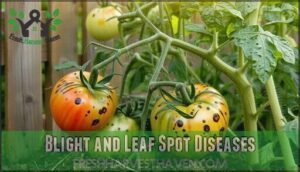This site is supported by our readers. We may earn a commission, at no cost to you, if you purchase through links.

These diseases typically fall into three categories: fungal infections that create white powdery coatings or dark spots on leaves, soil-borne pathogens that attack roots and cause wilting, and viral or bacterial diseases that spread rapidly between plants.
Watch for warning signs like yellowing leaves, unusual spots, stunted growth, or sudden wilting.
Most diseases thrive in humid conditions with poor air circulation, making prevention your best defense through proper plant spacing and watering techniques.
Understanding these patterns reveals specific strategies that can protect your garden before problems take hold.
Table Of Contents
- Key Takeaways
- Fungal Diseases Overview
- Soil and Root Diseases
- Viral and Bacterial Diseases
- Disease Prevention Methods
- Common Vegetable Diseases
- Frequently Asked Questions (FAQs)
- How do I keep bugs from eating my vegetable garden?
- What are the 5 plant diseases?
- What organic treatments work for fungal diseases?
- How do I identify diseased plants early?
- Can diseased plants spread to neighboring gardens?
- Which vegetables are most susceptible to diseases?
- When should I remove infected plants completely?
- Conclusion
Key Takeaways
- Watch for early warning signs like yellowing leaves, unusual spots, stunted growth, or sudden wilting – catching diseases early makes treatment much more effective and prevents spread to healthy plants.
- Focus on prevention through proper garden practices – maintain adequate plant spacing for airflow, water at soil level rather than overhead, and choose disease-resistant varieties to avoid problems before they start.
- Understand the three main disease categories – fungal infections (like powdery mildew and blight), soil-borne pathogens (like root rot and fusarium wilt), and viral/bacterial diseases that spread rapidly between plants.
- Practice good sanitation and maintenance – remove infected plant material immediately, sterilize tools between cuts, improve soil drainage, and avoid working in wet conditions to prevent disease transmission.
Fungal Diseases Overview
You’ll encounter several types of fungal diseases that can damage your vegetable garden, from the telltale white powder of mildew to the dark spots of blight.
Understanding these common fungal problems helps you identify issues early and take action before they spread throughout your plants, which is crucial for maintaining a healthy garden and preventing the spread of blight.
Powdery Mildew Symptoms
How do you spot powdery mildew creeping into your vegetable garden?
This fungal disease starts as small, circular white spots on leaf surfaces. These powdery patches spread rapidly, eventually covering entire leaves with a felt-like coating.
Early leaf infection appears on young growth first, making mildew control essential for plant resistance and preventing widespread white fungus damage throughout your garden.
Downy Mildew Causes
Downy mildew thrives in humid conditions when fungal spores find their perfect storm of moisture and stagnant air.
You’ll notice this garden disease loves moist environments where poor airflow creates a breeding ground for fungal infections.
Unlike powdery mildew, downy mildew needs wet leaf surfaces to establish itself.
Remove infected leaves immediately and apply fungicides to prevent spread.
Early and Late Blight Effects
Both early blight and late blight create devastating fungal infections that threaten your tomato and potato crops.
Early blight symptoms include dark brown lesions with distinctive concentric rings, while late blight causes water-soaked spots that rapidly expand into gray-green patches.
These tomato diseases can trigger severe plant damage and significant crop loss within days, making prompt disease cycle interruption through proper plant disease management essential.
Effective early blight treatment methods can help prevent the spread of disease and reduce crop loss, ensuring a healthier harvest through proper plant disease management.
Leaf Spot and Rust Identification
You’ll recognize Leaf Spot through yellow or brown lesions that form on your plants’ foliage.
These Fungal Signs appear when wet conditions combine with poor airflow.
Rust Identification becomes simple once you spot those telltale reddish-brown spots that give this disease its name.
Both Plant Pathogens weaken your vegetables by causing leaves to drop prematurely.
Disease Diagnosis involves checking leaf undersides for spores.
Soil and Root Diseases
Soil and root diseases attack your plants below ground, often before you notice symptoms above.
These sneaky problems can destroy entire crops if you don’t catch them early and take action.
Root Rot Prevention
Root rot destroys your garden’s foundation when soil stays too wet. Poor drainage creates the perfect breeding ground for harmful fungi that attack plant roots, turning them mushy and brown.
Prevent root rot with these water management strategies:
- Improve soil drainage by adding compost or perlite to heavy clay soils
- Water deeply but less frequently to encourage strong root development
- Check soil moisture before watering – stick your finger two inches down
Proper soil health starts with understanding your plants’ water needs. Most vegetables prefer well-draining soil that feels slightly moist, not soggy. Good garden maintenance includes monitoring drainage after heavy rains and adjusting your watering schedule accordingly. Accurate soil moisture levels can be determined using a soil moisture meter.
Fusarium Wilt Management
Fusarium wilt strikes when soil-borne fungi invade plant roots, causing devastating yellowing and wilting in your vegetable garden.
This persistent pathogen survives up to 10 years in soil, making Fusarium control essential for long-term garden success.
| Management Strategy | Effectiveness |
|---|---|
| Resistant varieties | Up to 80% loss reduction |
| Soil solarization | 90% pathogen reduction |
| Crop rotation | Gradual inoculum decrease |
You’ll need integrated plant disease management combining wilt prevention tactics.
Start with disease prevention through proper soil amendments and organic matter incorporation.
Practice crop rotation with non-host plants, and maintain excellent garden maintenance habits including tool sanitation.
Choose fungal resistance varieties whenever possible for sustainable vegetable garden health.
Verticillium Wilt Treatment
Unfortunately, you can’t cure Verticillium Wilt once it strikes your vegetable garden.
This stubborn fungal disease attacks plant roots and blocks water transport, causing yellowing leaves and plant death.
Your best defense involves removing infected plants immediately and planting resistant varieties.
Improve soil drainage and avoid replanting susceptible crops in contaminated areas for several years to prevent the spread of fungal disease.
Root-Knot Nematodes Control
Nematode management becomes your next priority when these microscopic worms attack plant roots.
You’ll notice stunted growth and small galls forming on root systems throughout your vegetable garden.
Here’s your three-step control strategy:
- Marigold planting – These flowers release compounds that repel root knot nematodes naturally
- Crop rotation – Move susceptible plants to different garden areas each season
- Biological control – Introduce beneficial nematodes that prey on harmful species
Soil fumigation offers another option for severe infestations, though it’s typically unnecessary for home gardens.
Viral and Bacterial Diseases
Unlike fungal diseases that spread through spores, viral and bacterial diseases in your vegetable garden operate differently and require specific management approaches.
You’ll need to recognize these diseases early since most have no cure once they establish in your plants, which is a critical aspect of gardening.
Fire Blight and Bacterial Canker
Bacterial infections wreak havoc when they target your fruit trees.
Bacterial diseases strike fast and spread faster through contaminated tools and wet weather conditions.
Fire Blight strikes apple and pear trees, creating scorched, blackened branches that look burned.
Bacterial Canker attacks stone fruits, forming dark spots and sunken areas.
Both spread through contaminated tree pruning tools and wet conditions.
These plant pathogens overwinter in infected tissue, making sanitation essential for preventing bacterial infections in your garden diseases management plan.
| Disease | Symptoms | Treatment |
|---|---|---|
| Fire Blight | Blackened, scorched branches; wilted flowers | Streptomycin sulfate spray during bloom |
| Bacterial Canker | Dark spots; sunken bark areas | Prune infected areas in dry weather |
| Prevention | Clean tools between cuts | Copper fungicide as preventive measure |
| Timing | Prune during dormant season | Apply treatments before wet weather |
| Spread | Contaminated tools and insects | Remove infected plant material immediately |
These diseases can be managed with proper prevention and treatment.
It is crucial to follow the guidelines for pruning and applying copper fungicide to prevent the spread of bacterial infections.
By taking these steps, you can protect your fruit trees from Fire Blight and Bacterial Canker.
Mosaic Virus and Aster Yellows
Viral symptoms in your garden can devastate entire crops if left unchecked. Mosaic virus creates distinctive mottled patterns on leaves, while aster yellows causes stunted growth and yellowing.
Viral diseases strike fast and spread faster—catching them early is your garden’s lifeline.
Disease transmission occurs through aphids, contaminated tools, and infected seeds.
Key viral disease indicators:
- Cucumber mosaic virus – Creates light and dark green patches on leaves, reducing yields up to 20%
- Mosaic effects – Twisted foliage and fruit deformation signal viral infection
- Plant viruses spread rapidly through sap-feeding insects like aphids and whiteflies
- Plant resistance varieties offer your best defense against these persistent viral diseases
Leaf Curl and Bacterial Leaf Spot
These two plant diseases can wreak havoc on your vegetable garden if left unchecked.
Leaf Curl causes young leaves to distort and curl, while Bacterial Leaf Spot creates dark lesions that spread rapidly during wet conditions.
Both diseases weaken plant defenses and reduce crop yields.
Proper disease prevention through good airflow and avoiding overhead watering strengthens disease resistance in vegetable gardening.
Understanding plant disease symptoms is essential for early detection and effective management of these diseases, including Leaf Curl and Bacterial Leaf Spot, to prevent crop yields reduction and ensure disease resistance.
Cucumber Mosaic Virus Transmission
Cucumber Mosaic Virus spreads rapidly through your garden via aphid vectors that carry plant viruses between vegetable crops.
This disease transmission creates significant crop loss when left unmanaged. Recognize plant disease symptoms early to protect your harvest.
Here’s how virus spread occurs:
- Aphid feeding – These tiny insects pick up the virus from infected plants and carry it to healthy ones
- Plant resistance varies – Some cucumber varieties show natural immunity while others remain highly susceptible
- Disease management timing – Early season infections cause the most severe damage to young plants
- Vegetable crops affected – Tomatoes, peppers, squash, and beans also fall victim to this widespread virus
Disease Prevention Methods
You can prevent most vegetable diseases by following proven garden practices that target the root causes of plant problems.
Smart prevention saves you time, money, and frustration while keeping your garden healthy all season long.
Improving Airflow and Watering
Proper air circulation and water management create the foundation for disease-free gardens.
Strategic plant spacing allows airflow to reduce humidity around leaves, while smart watering techniques target soil moisture without wetting foliage.
Effective disease prevention methods are essential for maintaining a healthy garden.
| Air Circulation Methods | Water Management Techniques |
|---|---|
| Space plants 18-24 inches apart | Use drip irrigation systems |
| Prune dense foliage regularly | Water at soil level only |
| Position gardens in windy areas | Avoid overhead sprinkler systems |
| Install fans in greenhouses | Water early morning hours |
Maintaining Soil Health
Healthy soil acts as your garden’s immune system, fighting off diseases before they take hold.
Regular soil testing reveals pH imbalances and nutrient deficiencies that weaken plants. Here’s how to build disease-resistant soil:
- Add compost benefits include introducing beneficial microbes that suppress soilborne diseases
- Improve drainage systems with raised beds to prevent waterlogged roots and fungal growth
- Balance fertilizer management to avoid excess nitrogen that attracts pathogens
- Maintain soil pH between 6.0-7.0 for ideal nutrient uptake and disease resistance
- Practice soil solarization during hot months to eliminate harmful organisms naturally
Quality organic matter boosts soil fertility while creating an environment where beneficial organisms thrive and harmful pathogens struggle, which is essential for a healthy garden ecosystem.
Pruning and Sanitation Techniques
Remove infected plant parts immediately using clean, sharp pruning tools sterilized between cuts with rubbing alcohol. Dispose of diseased branches and plant debris in trash, never compost.
Clean garden tools regularly to prevent spreading pathogens. Rake fallen leaves and remove dead stems during fall cleanup to eliminate overwintering disease sources.
Proper pruning techniques involve using high-quality pruning shears to make precise cuts, which is a critical step in preventing the spread of disease, and following these steps can help maintain a healthy garden ecosystem.
Planting Resistant Varieties
Smart gardeners know that choosing disease-resistant varieties is your best defense against plant diseases.
Disease resistance bred into modern cultivars can prevent many common problems before they start.
When selecting seeds or transplants, look for resistant cultivars marked with specific disease codes like "VF" for verticillium and fusarium wilt resistance.
This proactive crop selection saves time, money, and heartache later.
Using high quality disease resistant seeds is essential for a healthy harvest.
Common Vegetable Diseases
You’ll encounter several common diseases that can damage your vegetable garden plants throughout the growing season.
Understanding these diseases helps you spot problems early and take action before they spread to healthy plants, which is a complete concept that requires immediate action.
Powdery Mildew and Downy Mildew
Powdery mildew appears as white, chalky spots on leaf surfaces, while downy mildew creates yellowish patches with gray-purple fuzz underneath.
Both fungal diseases thrive in humid conditions but require different approaches for effective fungal management.
- Powdery mildew control: Increase air circulation and apply copper fungicides early in the season
- Downy mildew prevention: Remove infected leaves immediately and improve garden drainage systems
- Plant hygiene practices: Water at soil level and maintain proper spacing between plants for crop protection
Effective disease prevention involves understanding common garden diseases to implement targeted control measures.
Blight and Leaf Spot Diseases
Dark spots and yellowing leaves signal blight diseases attacking your tomato plants.
Early blight appears in May with brown spots and target-like rings, while late blight strikes later with greenish-black patches.
Septoria leaf spot creates small dark circles that cause plant defoliation.
These fungal infections spread rapidly in humid conditions, weakening disease resistance and reducing yields substantially.
Viral and Bacterial Disease Effects
Viral infections can devastate your vegetable garden, causing yield losses up to 98%.
Cucumber mosaic virus creates mottled leaves, while bacterial wilt blocks water transport, killing plants rapidly.
Fire blight scorches fruit trees, and bacterial spot creates dark lesions.
Plant viruses like aster yellows stunt growth, while fusarium wilt and verticillium wilt destroy root systems permanently.
Understanding viral disease symptoms is essential for effective garden management and prevention.
Frequently Asked Questions (FAQs)
How do I keep bugs from eating my vegetable garden?
Congratulations, you’ve joined the exclusive club of gardeners waging eternal war against tiny invaders.
Use row covers, companion planting with marigolds, neem oil sprays, and beneficial insects like ladybugs to protect your vegetables naturally.
This approach allows for a comprehensive defense strategy, combining multiple methods to safeguard your garden.
What are the 5 plant diseases?
You’ll commonly encounter these five plant diseases in your garden: powdery mildew creates white powdery spots, root rot causes wilting from overwatering.
Blight affects tomatoes with dark spots, bacterial wilt makes plants collapse, and mosaic virus creates mottled leaves.
What organic treatments work for fungal diseases?
Copper fungicide sprays absolutely demolish most fungal diseases when you catch them early.
You’ll also want to improve airflow around plants and water at soil level, not overhead, to keep leaves dry and fungi frustrated.
How do I identify diseased plants early?
Check leaves regularly for early warning signs: yellowing, brown spots, white powdery coating, wilting, or unusual growths.
Look for changes in leaf texture, color patterns, or stunted growth that signal disease development.
Can diseased plants spread to neighboring gardens?
Yes, diseased plants absolutely can spread to neighboring gardens.
Wind carries fungal spores and bacteria across property lines, while insects like aphids transmit viruses between yards, making disease management a community-wide concern.
Requiring vigilant monitoring is crucial, as it helps in identifying and addressing the spread of diseases promptly.
Which vegetables are most susceptible to diseases?
Tomatoes face early and late blight, fusarium wilt, and mosaic virus. Cucumbers battle bacterial wilt, mosaic virus, and powdery mildew. Potatoes struggle with blight and rot issues frequently.
When should I remove infected plants completely?
Surprisingly, 16% of growers rank powdery mildew as their third biggest concern.
You should remove plants immediately when viral diseases like mosaic virus or bacterial wilt appear, since there’s no cure and they’ll spread rapidly.
Conclusion
Think of garden diseases like uninvited party guests – they’re easier to prevent than to remove once they’ve settled in.
Successfully managing common vegetable garden plant diseases requires understanding their warning signs and implementing preventive measures before problems escalate.
You’ll protect your harvest by maintaining proper plant spacing, ensuring adequate airflow, and practicing good sanitation.
Early detection combined with targeted treatment keeps your vegetables healthy and productive throughout the growing season, which is crucial for a healthy harvest.
- https://pmc.ncbi.nlm.nih.gov/articles/PMC7604890/
- https://portal.ct.gov/CAES/Fact-Sheets/Plant-Pathology/Selected-Bacterial-Diseases-of-Vegetables
- https://pubmed.ncbi.nlm.nih.gov/38675944/
- https://ipm.ucanr.edu/agriculture/floriculture-and-ornamental-nurseries/viruses-and-viroid-diseases/
- https://ausveg.com.au/knowledge-hub/crop-protection/bacterial-diseases-in-vegetable-crops/












